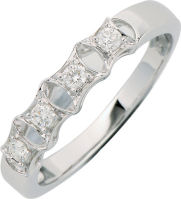IIJS Expectations: Time For Industry To Rally
August 01, 12
 |
He adds, “From the feedback that many retailers have given me, they’re going to keep their purchases strictly to what is absolutely necessary. Many told me they are melting and recycling their old jewelry to come up with new, lightweight product without going to the cost of completely new acquisitions. So don’t expect to see too much product innovation from manufacturers either.”
Sanghani goes on to explain, “Let’s face it, the economy is not going anywhere and consumer sentiment is down. We all know that and so in terms of generating business, no one’s expecting much of the India International Jewellery Show (IIJS) – the only really serious buyers are going to be those who have just opened new stores and have no option but to stock up,”
“But,” he adds, “I don’t think we should all just sit around and wait for something to happen – hope for some new government initiative to pull the country out of the economic doldrums. We have got to make something happen ourselves. For the gem and jewelry industry, I think it is crucial to come together and launch some sort of concerted promotion and marketing effort for our product. The industry came together surprisingly well over the issue of the proposed excise duty on jewelry. We’ve got to do something similar about marketing and promotion.”
Mahesh Rao, CEO of Peakok Jewellery, that manufactures and distributes product for jewelry retailers throughout the country, concedes that these aren’t good times. “Yes, it is a tough year,” he admits, “but you’ve got to take a step back and look at the big picture. Jewelry has been selling in this country for some 5,000 years – and you can bet there have been some horribly bad times over all that time.”
Rao observes, “Jewelry sold when the foreign exchange rate was Rs.7.50 to the US dollar and it will still be selling if it goes up to Rs.60 to the dollar. So what is the worst that can happen if we have on bad year?”
He thinks this is the time for the Indian gem and jewelry industry to start thinking long-term about its product. “Developing contemporary design has to be a priority long-term goal for us,” he observes. “The product development and manufacture part of the process are relatively short-term, what I’m talking about is getting down to really understanding what moves and motivates consumers and how to come up with product they will want – actively seek out.”
As it is, Rao observes, the Indian jewelry production industry is still operating way below capacity. “We’re only operating at some 60 percent of our installed capacity, so even if there had been a surge in demand, it isn’t as though we could have rushed to meet it. I think the depressed consumer market now offers us a chance to think about the long term instead of just trying to figure out how to cope with the here and now.”
Work Towards Next Year
The way Rao puts it, “We’ve got to start working on being ready for next year.” He looks back at the recent past and points out, “We had a really good run up from the 1990s through to 2010. But we never really got to grips with what excites the consumer and what we could do to create some longing for our product.”
Rao thinks the way forward is for the industry to go to the very bottom of the product pyramid. “A really solid way forward is to look at the traditional craftsmen who have been turning out jewellery product for thousands of years in this country. We need a World Craft Council tie-up and get to grips with what the traditional craftsmen have done all these years – to create all those traditions that are so famous now.”
Rao wants to build up slowly but solidly. “I think we should work on some four crafts this year and work at them thoroughly. That’s the way forward. We have to stop crying about the present and prepare ourselves to start investing in the future. We have to do something aimed at the long term. The time to do it is now.”
Gem & Jewellery Export Promotion Council (GJEPC) Vice Chairman Sanjay Kothari, whose Diatrends Jewellery is a regular participant at the IIJS show, is also candid when he says the outlook isn’t all that hot. “It you look at the way the JCK Las Vegas and Hong Kong shows went, you know for sure that the outlook isn’t so great,” he notes.
He elaborates, “India is now firmly connected to the global economy and the global economy is going through uncertain times. Add the fact that our domestic political and economic outlook is pretty uncertain right now and you don’t have to be some great forecaster to know that the IIJS is going to be sailing in a tough current. Personally, we at Diatrends are therefore banking on our usual product – small diamonds below 0.10 carat to base our product offering for the show on. And even then, who knows?”
But Kothari too doesn’t think the situation calls for a passive throwing in of the towel. “If you look at the signs, the gem and jewelry industry isn’t just giving up, they know that there are better times that will come in the future. There is a waitlist of some 479 companies waiting to get exhibition space at the IIJS. And as for the India International Jewellery Week (IIJW) that runs over the week just preceding the IIJS, all 32 designer-manufacturer slots have been taken, with the Gemological Institute of America (GIA) and the International Gemmological Institute (IGI) sponsoring a whole slew of new designers. In fact, there’s so much pressure that we’re looking at perhaps expanding the show and increasing the participation.”
The Japanese Are Coming
Another initiative that will run through the IIJW is the special participation of the Japanese jewelry retail industry. “It is the 60th year of the Indo-Japan business association and they are looking to do something special to commemorate it.”
 |
All the signs do indeed point to an Indian industry that does not seem the slightest bit negative about the future. At a press conference hosted by the GJEPC, IIJS convener Haresh Zaveri announced that this year’s show, the 29th edition, would feature over 800 exhibitors in 1,900 booths.
Zaveri told the media that the show, which is hard-pressed for space, is looking at a variety of options to try and accommodate the 479 companies that want to get in as exhibitors. One solution being offered to prospective exhibitors is the multi-user mezzanine booth. Zaveri explained that this meant that booths could be erected with upper or mezzanine floors that would house companies other than those on the ground floor. Hitherto, mezzanine floors have been simply expansions of the ground-floor exhibitor’s own exhibition area.
“Our focus is on offering new exhibitors space at the show rather than granting existing exhibitors more space,” Zaveri said. “Any cancellations among participants would mean that the freed-up space would be offered to someone from the waitlist rather than being given as extra space to existing exhibitors.”
Zaveri said 1,800 overseas buyers were expected this year as compared to last year’s 1,300. He added that between 650 and 700 buyers had already registered for the show.
Indeed, the future of the Indian gem and jewellery industry – and the strength of consumer demand in the country – looks so good for the future that neighbouring Pakistan is sending a 100-member delegation to this year’s show and the GJEPC is working towards providing them with a fully-fledged Pakistani pavilion at the 2013 IIJS.
Time To Start Really Understanding The Consumer
Many industry watchers think that this is the time for the Indian gem and jewelry industry to indeed take stock of what it could do to ensure that the future remains as rosy as the past has been. The development of design apart, much of what needs to be done is cited as a glaring need even in other retail sectors. Primarily, this is about really understanding the consumer.
In a report that it published in September last year, retail consultants Technopak had noted, “The success of many retailers across the world and the failure of others can be attributed to one major silver bullet – how well a retailer has changed its organization to become customer-centric, by collecting and analyzing customer data and making strategies based on insights gleaned from the data. This outlook explains why it has become imperative for the organized retail sector in India to embark on a journey of customer centricity and how they could go about doing so, by an effective use of customer data.”
The Technopak report went on to note, “The most fundamental aspect of developing customer-centricity is to understand the customers and for this, collecting data on who they are, what they buy, when they buy, how they buy, etc. is of paramount importance. It is very important for Retailers to set up robust and excellent processes which will enable them to collect customer data. One of the biggest drawbacks that the Indian retailers have is that their existing systems and processes have not been built to capture customer data or link it to the transactions…”